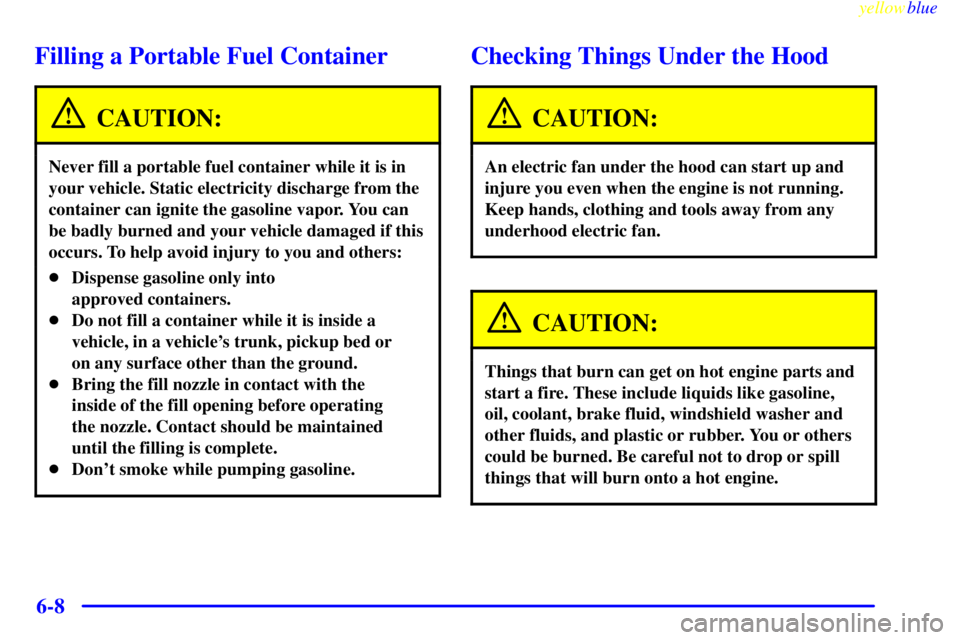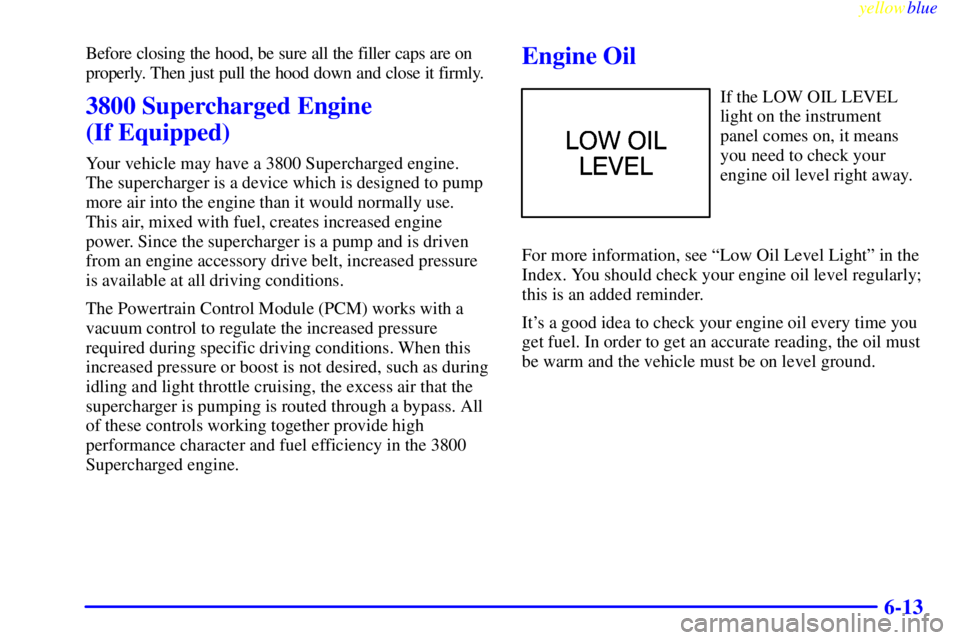Page 141 of 376
yellowblue
2-81
Here are four things that some owners ask about. All
these things are normal and do not indicate that anything
is wrong with the fuel gage:
�At the gas station, the pump shuts off before the gage
reads F (FULL).
�It takes a more (or less) fuel to fill up than the gage
reads. For example, the gage reads half full, but it
took a more (or less) than half the tank's capacity to
fill it.
�The gage pointer may move while cornering, braking
or speeding up.
�The gage may not indicate E (EMPTY) when the
ignition is turned off.Low Fuel Light
If your fuel is low, the
warning light near the fuel
gage will go on.
It will also come on for a few seconds when you first
turn on the ignition as a check to show you it's working.
If it doesn't come on then, see your dealer.
Page 264 of 376

yellowblue
6-8
Filling a Portable Fuel Container
CAUTION:
Never fill a portable fuel container while it is in
your vehicle. Static electricity discharge from the
container can ignite the gasoline vapor. You can
be badly burned and your vehicle damaged if this
occurs. To help avoid injury to you and others:
�Dispense gasoline only into
approved containers.
�Do not fill a container while it is inside a
vehicle, in a vehicle's trunk, pickup bed or
on any surface other than the ground.
�Bring the fill nozzle in contact with the
inside of the fill opening before operating
the nozzle. Contact should be maintained
until the filling is complete.
�Don't smoke while pumping gasoline.
Checking Things Under the Hood
CAUTION:
An electric fan under the hood can start up and
injure you even when the engine is not running.
Keep hands, clothing and tools away from any
underhood electric fan.
CAUTION:
Things that burn can get on hot engine parts and
start a fire. These include liquids like gasoline,
oil, coolant, brake fluid, windshield washer and
other fluids, and plastic or rubber. You or others
could be burned. Be careful not to drop or spill
things that will burn onto a hot engine.
Page 269 of 376

yellowblue
6-13
Before closing the hood, be sure all the filler caps are on
properly. Then just pull the hood down and close it firmly.
3800 Supercharged Engine
(If Equipped)
Your vehicle may have a 3800 Supercharged engine.
The supercharger is a device which is designed to pump
more air into the engine than it would normally use.
This air, mixed with fuel, creates increased engine
power. Since the supercharger is a pump and is driven
from an engine accessory drive belt, increased pressure
is available at all driving conditions.
The Powertrain Control Module (PCM) works with a
vacuum control to regulate the increased pressure
required during specific driving conditions. When this
increased pressure or boost is not desired, such as during
idling and light throttle cruising, the excess air that the
supercharger is pumping is routed through a bypass. All
of these controls working together provide high
performance character and fuel efficiency in the 3800
Supercharged engine.
Engine Oil
If the LOW OIL LEVEL
light on the instrument
panel comes on, it means
you need to check your
engine oil level right away.
For more information, see ªLow Oil Level Lightº in the
Index. You should check your engine oil level regularly;
this is an added reminder.
It's a good idea to check your engine oil every time you
get fuel. In order to get an accurate reading, the oil must
be warm and the vehicle must be on level ground.
Page 321 of 376
yellowblue
6-65
Fuse Description
30 Alt Sense
31 Torque Converter Clutch (TCC)
32 Fuel Pump
33 Electronic Control
Module/Powertrain Control
Module
34 Spare
35 Fog Lamps
36 Horn
37 Chime/Mall Module, Taillamps,
Parking Lamps, Sidemarker
Lamps, Dimmable Lamps
38 Spare Fuse
39 Fog Lamps
40 Spare
Air Conditioning Clutch Diode Relay Description
9 Cooling Fan
10 Cooling Fan 2
11 Ignition Main
12 Cooling Fan 1
13 Air Conditioning Clutch
14 Fuel Pump
15 Fuel Pump Speed Cont
16 Horn
17 Fog Lamp